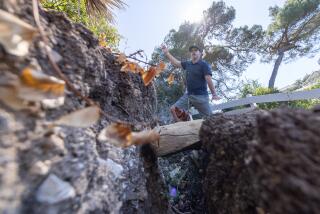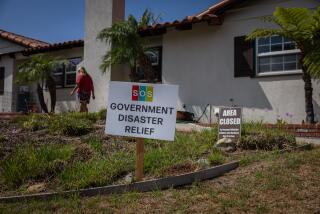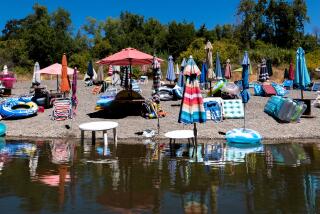Shifting Sands Prompt Ventura Debate : Beaches: Some homeowners like the idea of sand dunes on the beach. Others complain dunes would obstruct their view.
- Share via
A cadre of beachfront homeowners scrambling to fight the forces of nature this week persuaded the Ventura City Council to help homeowners keep the ocean from their doorstep.
Agreeing to find ways to standardize city guidelines to remove sand along Ventura’s beaches, council members resurrected debate over the creation of dune barriers on the waterfront along Pierpont Bay.
But what some property owners see as a boon may be a bane for others. While some homeowners like the idea of sand dunes on the beach, others complain dunes would obstruct their view.
“One of the things that’s going to be a real problem is that people have a different perception of whether dunes ought to be there or not,” Councilman Donald Villanueve said.
Villanueve, an environmental science instructor at Ventura College, cautioned against tinkering with the natural balance of the beaches. Attempts to create dunes in other areas have met with limited success, he said.
Until recently, Pierpont-area property owners were bulldozing sand back onto the beach without having to seek permits from public agencies.
Nearly three years ago homeowner Carolyn Hiller found her front door inundated with sand and called a contractor to remove it, as she has had to do before in the 14 years since she bought her home in the 1100 block of Bangor Lane.
When workers began to move the sand, she was told she could not move sand back onto the beach without seeking a permit from the city and completing an environmental study on moving sand.
“Why am I as a private citizen funding a study to do a stabilization study of a public beach? We all use the beach, it’s not my private beach,” Hiller said.
Hiller, 49, said she was turned away by one agency after another in her crusade to remove sand around her property. At one point, city officials suggested she use hand shovels to remove an estimated 2 million pounds of sand around her three-bedroom house.
“My husband went absolutely crazy. He said, ‘We’re really going to move 2 million pounds of sand by hand!’ ” Hiller recalled.
Last week Hiller removed roughly 30 truckloads of sand from her property, but had to pay $2,300 to transport it to the only area where it was allowed to be moved, near the Ventura pier.
The Hillers’ problem with shifting sand highlights a general problem faced by Santa Barbara and Ventura counties, where erosion and shifting sand threaten homes built along the Pacific shore.
In some areas along the stretch south of the Ventura pier to the Ventura Harbor, homeowners have found their own solutions to a natural problem, erecting retaining walls to shield their properties from the constant onslaught of wind and waves.
The Hillers constructed plywood barriers in front of the glass doors of their one-story home to prevent the weight of the sand from shattering them.
Other individual homeowners have shored up banks of sand and cultivated ice plants and ground cover to create their own artificial dune.
History shows that the effect of storms and continuous waves is to erode the beach. Homeowners along Ventura’s coastal route saw the ocean eat up what was once Shoreline Drive in 1939. Erosion was a problem in the 1950s, when it was decided that jetties were needed to replenish sand on the beach.
The Army Corps of Engineers in 1967 completed a series of seven jetties and filled in the stretches of beach with 882,000 cubic yards of sand.
Since then, the sand has continued to shift, according to a 186-page report released last July by the Beach Erosion Authority for Control Operations and Nourishment, also known as BEACON.
The report, generated by city and county agencies in Ventura and Santa Barbara counties, called for a concerted effort to prevent beach erosion, including a dune stabilization program.
But not all homeowners in the Pierpont area agree that dunes would provide protection from the force of winter storms.
Maria Maginnis, 76, whose home fronts the shore on Cornwall Lane, said the dunes would block her view of the shore and may heighten the force of waves during a storm.
“I think it’s the worst solution,” Maginnis said. “If I have a big dune out there a wave is going to gain tremendous force and hit me.”
As the debate over creating a dune barrier rages, the price of preserving sand on the beaches and maintaining it there has swelled. Costs of replenishing beaches with sand have grown in recent years, according to the BEACON report, and “continuation of this trend could result in more projects becoming uneconomical even in high recreational demand areas.”
Funding sources remain critical, and the city has looked for resources to fund a dune program through the Coastal Commission and the Coastal Conservancy, so far without success, said Everett Millais, community development director. City officials are planning to hold a one-day conference in the spring to discuss financial and environmental concerns regarding dunes.
The council may eventually be asked to fund the program through its own capital improvement and maintenance budgets, said Barbara Fosbrink, coastal project manager for the city.
“It’s a natural cyclical dynamic that goes on there. And when we get in there and mess with it, you’re going to create problems,” Fosbrink said. “An answer for one part of the beach doesn’t work for another part of the beach, but dunes will help everybody.”
More to Read
Sign up for Essential California
The most important California stories and recommendations in your inbox every morning.
You may occasionally receive promotional content from the Los Angeles Times.










